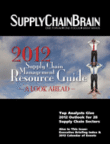
Visit Our Sponsors |
|
|
|
|
|
|
|
|
|
|
|
|
|
|
|
|
|
|
|
|
|
|
|
|
|
|
|
|
|
|
|
|
|
|
|
|
|
|
|
|
|
|
|
|
|
|
|
|
|
|
|
|
|
|
|
|
|
|
|
|
|
|
|
|
|
|

With increasing visibility and collaboration through demand-driven views - extending from customers' customers to suppliers' suppliers - S&OP has the potential to reshape supply chain management fundamentally. And this is true no matter what it is called: S&OP, SIOP (sales, inventory and operations planning) or IBP (integrated business planning) - the acronym is immaterial. The firms that exploit the concept fully will gain competitive advantage that most competitors cannot replicate by any other business strategy.
S&OP has come a very long way. It was developed to bring formal structure to hallway and email decision making for emergencies in manufacturing. Prior to the beginning stages of the evolution, some conversations between sales, manufacturing, planning and finance were as follows:
• Sales: "Just got this new customer order, stop producing A and change to B";
• Manufacturing: "Just finished the set-up and are on-spec on A";
• Planning: "Wait, we don't want to be out of B next month";
• Finance: "But we could use the margin now."
Since that time, S&OP has evolved:
• From tactical to strategic
• From manufacturing to retail
• From operational to mid-management and executive
• From individual locations to supply chains
• From SKUs to product categories
• From situation-driven to planned and periodic
The best S&OP processes vary in the details due to the nature and needs of the businesses. However, the fundamentals are the same: Frequently rebalance supply and demand, to the needed extent, through structured operational-, managerial- and executive-level collaborative decision processes that reflect corporate objectives. The potential for increased competitive advantage and profit improvement is significant, especially in large firms that have disconnected demand planning and supply management organizations, as well as weak supplier relationship management programs.
There are a number of crucial keys to success and a significant potential for failure. In 2009, Gartner defined a solid four-stage view of the maturity of S&OP processes - reacting, anticipating, collaborating, orchestrating. At the same time, Gartner recognized that the majority of initiatives did not progress beyond the first or second stage.
There may be data challenges, especially for firms that have exceptionally disconnected demand planning and supply management. However, the larger challenges are managerial and cultural, particularly for firms that have limited collaboration experience. And, while suppliers do not have to be included, benefits can be maximized when key suppliers are involved. This is an especially difficult challenge when the foundation for supply chain collaboration has not been established and strengthened over time.
The S&OP process plays a major role in breaking down the walls of organizational silos. The process is explicitly designed to bridge from customer demand planning to supply management (i.e., manufacturing or purchasing) almost inevitably spanning white space on the organization chart. Reflecting this reality, Gartner accurately characterizes the effort as 60 percent change management, 30 percent process, and 10 percent technology.
On the other hand, the S&OP process can drive the desired collaboration, which has been more of an objective than a reality in the past. Or will it become the primary general management tool for businesses that have supply chains as their core competency?
The Outlook
Manufacturers without an institutionalized process are far behind the leading-edge farms. And although distributors and retailers may be behind manufacturing companies, 2012 is a good time to begin utilizing S&OP. No one wants to be last.
RELATED CONTENT
RELATED VIDEOS
Timely, incisive articles delivered directly to your inbox.






